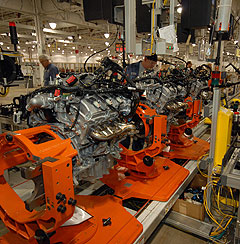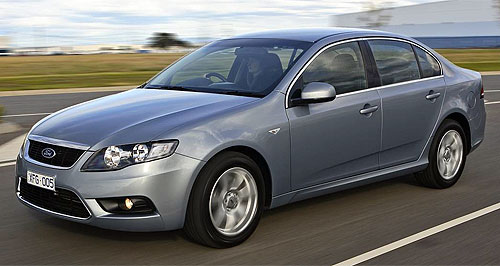Future models - Ford - FalconFord tests rear-drive 4cyl engine for FalconFamous four: The Ford Falcon's new EcoBoost four-cylinder engine is meeting its test targets, says Ford. Countdown begins to Ford’s EcoBoost future as it starts 4cyl test regime11 Sep 2009 FORD Australia has begun local testing of its forthcoming EcoBoost four-cylinder engine in ‘Falcon configuration’ in readiness for its 2011 debut as the fuel-efficiency hero for the locally made large car. Ford Australia president and CEO Marin Burela confirmed the testing regime in Melbourne today, although he stopped short of saying the engine – featuring a combination of direct injection and turbocharging for high fuel efficiency and strong torque – had actually been fitted to a Falcon test car. Asked at a media briefing if EcoBoost was being tested in Falcon, Mr Burela said: “We have test vehicles that we have been testing. We use different types of vehicles. We have mules that have the Falcon configuration.”‘Falcon configuration’ means driving the rear wheels, as the big Australian car will be the world-first application of the high-efficiency 2.0-litre petrol engine in that mode. Front-wheel drive applications are destined to hit the showrooms in the United States next year, in cars such as the Ford Fusion, as Ford spreads the technology across its range around the globe.  Left: The Cleveland Engine Plant becomes the first Ford manufacturing site in the world to produce EcoBoost engines in V6 guise. Left: The Cleveland Engine Plant becomes the first Ford manufacturing site in the world to produce EcoBoost engines in V6 guise.Mr Burela said the Falcon four-cylinder EcoBoost program was on target, although he lamented the fact that Ford would have to wait until 2011 to get it in the showrooms. “I’d like to have all these technologies here in three months,” he said, referring also to the diesel engine for the Territory due in 2011. Ford will have to soldier on with its 4.0-litre Falcon until the EcoBoost engine arrives, against Holden’s new 3.0-litre SIDI direct-injection V6 which has just stolen the big Ford’s crown as Australia most fuel-efficient local six, with a fuel efficiency average of 9.4L/100km. Mr Burela said the EcoBoost engine, despite its apparent small size, would be a revelation to large-car buyers. “I think it is going to be a huge surprise and delight for the market because it will give people an incredible option,” he said. “The EcoBoost technology, being a direct-injected turbo-charged four-cylinder engine, will give us the power, will give us the fuel efficiency and CO2 reductions.” Mr Burela said tests on the engine’s power-to-weight ratio, performance, take-off speed and torque indicated “this will be very good”. He dismissed suggestions that the small engine – half the size of the Falcon’s usual 4.0-litre inline six – would have trouble hauling such a large car. “Once a upon a time we used to all drive 5.8-litre V8s and we couldn’t work out how we could get a six-cylinder turbo to perform like a V8,” he said. “It is the same argument we have today.” Mr Burela said that although fleets were still buying large six-cylinders cars such as the Falcon and Commodore, they really wanted to buy four-cylinder cars. “They are buying a lot of imported four-cylinders,” he said. “They (the imports) are very desirable. “What is not desirable is giving them a car that costs an arm and a leg to run, and they are driving around feeling anti-social because they are emitting CO2 at levels that are not socially acceptable. “So what we have now got is an incredibly compelling story with every one of our vehicles when we introduce this technology.” The EcoBoost Falcon would give fleets and private buyers alike the opportunity of buying a four-cylinder car of high efficiency without compromising car size or comfort and features, he said. Mr Burela said affordability would be a key to EcoBoost, providing fuel efficiency at the right price. “To us, EcoBoost will be an affordable technology that will be available to those people to choose to buy into that proposition,” he said. “It will not be the stripped out Falcon with only a driver’s seat because the four-cylinder won’t be able to pull it.” Mr Burela said Ford’s fuel-efficient product strategy would be based on EcoBoost. “Are we working on electrification? You betcha. Are we working on hybrids? Yes we are are. Are we working on a whole range of other technologies? Yes we are. “What we also know is that for 106 years since Henry Ford started Ford Motor Company, one of the great requirements – the vision – was to provide affordable transportation to the people. EcoBoost does that. “So you won’t be paying a significant premium for a hybrid to go out and enjoy the pleasures of driving in a family car that is environmentally responsible, has great fuel economy and is a great package for a country the size of Australia.” Mr Burela said Ford Australia’s green credentials would be strengthened by the arrival in November of the ECOnetic diesel Fiesta, which he said would be “Australia’s most efficient car”. The Fiesta is expected to have an average fuel economy figure of 3.7 litres per 100km and a carbon emission rating of 98g/km, undercutting the just-introduced Mini D (3.9L/100km) and Toyota Prius (3.9L/100km). Mr Burela indicated that Ford Australia would consider expanding availability of ECOnetic diesel engines in its range – including Focus and Mondeo – depending on the success of the Fiesta version. Ford will showcase the ECONetic Fiesta in October’s Global Green Challenge event from Darwin to Adelaide, along with an XR6 turbo Falcon. While Ford is highlighting its ‘green’ engines, Mr Burela said he saw a strong future for Falcon’s inline-six cylinder engine, which would be upgraded to meet the Euro 4 emissions standard that becomes mandatory in Australia on July 1 2010. He also said Ford would continue to sell V8 engines in its range while customers still wanted them.  Read more11th of August 2009  Ford ‘delight’ at Holden superiority claimsFord chief says future product will disprove Holden promise to ‘out-engineer'27th of July 2009  Ford Falcon EcoBoostedFalcon to plug in to global Ford plan with direct-injection 2.0-litre EcoBoost27th of July 2009  Falcon ‘four’ guns for fleetsFord aims to recapture fleet business with fuel-friendly EcoBoost four-cylinderAll future models Alfa Romeo Alfa Romeo Abarth Abarth Audi Audi Aston Martin Aston Martin BMW BMW Bentley Bentley Chrysler Chrysler Chevrolet Chevrolet Dodge Dodge Citroen Citroen Ferrari Ferrari DS DS Ford Ford Fiat Fiat FPV FPV Foton Foton Haval Haval Great Wall Great Wall Honda Honda Holden Holden Hyundai Hyundai HSV HSV Isuzu Isuzu Infiniti Infiniti Jeep Jeep Jaguar Jaguar Lamborghini Lamborghini Kia Kia Lexus Lexus Land Rover Land Rover Mazda Mazda Maserati Maserati Mercedes-Benz Mercedes-Benz McLaren McLaren Mini Mini Nissan Nissan Mitsubishi Mitsubishi Peugeot Peugeot Opel Opel Proton Proton Porsche Porsche Renault Renault Ram Ram Saab Saab Rolls-Royce Rolls-Royce Smart Smart Skoda Skoda Subaru Subaru SsangYong SsangYong Tesla Tesla Suzuki Suzuki Toyota Toyota Volvo VolvoMotor industry news |
Click to shareFord modelsResearch Ford All future models Alfa Romeo Alfa Romeo Abarth Abarth Audi Audi Aston Martin Aston Martin BMW BMW Bentley Bentley Chrysler Chrysler Chevrolet Chevrolet Dodge Dodge Citroen Citroen Ferrari Ferrari DS DS Ford Ford Fiat Fiat FPV FPV Foton Foton Haval Haval Great Wall Great Wall Honda Honda Holden Holden Hyundai Hyundai HSV HSV Isuzu Isuzu Infiniti Infiniti Jeep Jeep Jaguar Jaguar Lamborghini Lamborghini Kia Kia Lexus Lexus Land Rover Land Rover Mazda Mazda Maserati Maserati Mercedes-Benz Mercedes-Benz McLaren McLaren Mini Mini Nissan Nissan Mitsubishi Mitsubishi Peugeot Peugeot Opel Opel Proton Proton Porsche Porsche Renault Renault Ram Ram Saab Saab Rolls-Royce Rolls-Royce Smart Smart Skoda Skoda Subaru Subaru SsangYong SsangYong Tesla Tesla Suzuki Suzuki Toyota Toyota Volvo VolvoMotor industry news |
















Facebook Twitter Instagram